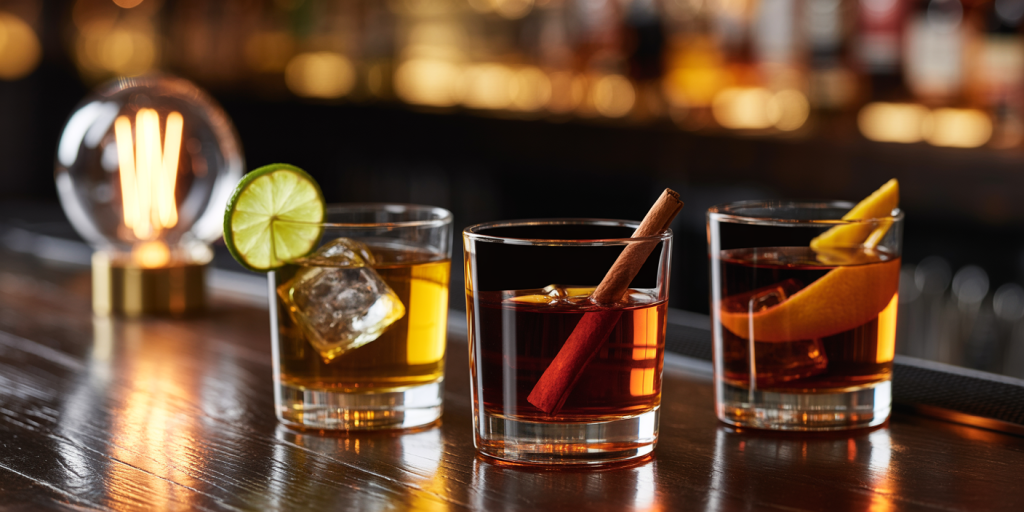Classic cocktails have long been celebrated as the foundation of mixology. Drinks like the Martini, Old Fashioned, and Negroni have transcended eras, offering defined flavors and a ritualistic approach to social drinking. However, as tastes evolve and bartenders push the boundaries of innovation, these iconic cocktails have begun to see inventive spins—often referred to as “classic cocktails with a twist.” This transformation not only preserves the heritage of the original recipe but also invigorates it with new ingredients, techniques, and presentations aimed at capturing contemporary interest.
Exploring these reimagined concoctions reveals much about how the beverage industry adapts to shifting consumer preferences, the rise of craft spirits, and global flavor influences. According to the 2023 Drinks International report, craft and innovative cocktails have seen a 25% increase in sales worldwide in bars and restaurants, highlighting a robust appetite for modern renditions of traditional drinks. This article delves into the essence of these classic cocktails, their modern twists, the cultural and culinary implications, and future trends impacting mixology.

The Art of Reinventing the Martini
The Martini epitomizes cocktail sophistication, traditionally composed of gin and dry vermouth and garnished with an olive or lemon twist. Despite its simplicity, the Martini has been continuously reinvented to meet changing tastes. Modern bartenders experiment with gin substitutions, vermouth variations, and even flavor infusions to create new taste profiles while respecting the cocktail’s iconic status.
One popular twist is the use of botanical gins infused with exotic herbs and spices, such as elderflower or cucumber, which impart refreshing floral or vegetal notes. For example, the “Cucumber Elder Martini” replaces a standard London Dry gin with a cucumber-infused gin, paired with elderflower vermouth. This variation balances herbal aromas and crispness, appealing to health-conscious consumers looking for lighter, less alcoholic options.
Another noteworthy evolution is the “Dirty Martini 2.0,” which amplifies the traditional olive brine component with house-made olive powders or pickled water from specialty olives. This approach deepens the savory umami flavor without overpowering the drink. According to the American Bartenders Association, such nuanced variations have increased Martini orders in upscale bars by 18% over the past two years, signaling renewed interest driven by creative reinterpretations.
Reimagining the Old Fashioned: Beyond Bourbon
The Old Fashioned, a classic whiskey cocktail, is known for its simple yet robust combination of bourbon, sugar, bitters, and a citrus garnish. It enjoys a status as the most ordered cocktail in many bars worldwide. However, bartenders today experiment beyond bourbon, exploring alternative base spirits and infusion methods to both maintain and diversify its flavor appeal.
For instance, the “Tequila Old Fashioned” substitutes bourbon with añejo tequila, emphasizing a smokier, agave-forward profile. This twist caters to the rising popularity of tequila and mezcal worldwide, which grew by 40% in global spirits consumption in 2022, according to IWSR Drinks Market Analysis. Using aged tequila offers woody, caramel undertones compatible with the classic Old Fashioned’s bitters and sugar.
Another trending variant is the “Rum Old Fashioned,” incorporating blackstrap rum for a richer, sweeter, and spicier flavor palette. This variation, popularized in Caribbean-inspired cocktail bars such as New York’s “Rum House,” draws on the Caribbean’s cultural connection to rum production and mixology. Such experiences reflect consumers’ growing preference for diversified spirit choices and more complex flavor layers without departing too far from familiar frameworks.
| Classic Old Fashioned | Twisted Variants | Flavor Characteristics |
|---|---|---|
| Bourbon, sugar, bitters | Añejo tequila, brown sugar, angostura | Woody, caramel, smoky |
| Blackstrap rum, demerara sugar, aromatic bitters | Sweet, rich, spiced | |
| Garnish: orange twist | Garnish: grilled lime or cinnamon stick | Citrusy to smoky aromatic |

Innovative Spins on the Negroni
The Negroni is renowned for its perfect balance of bitter, sweet, and herbal notes from equal parts gin, Campari, and sweet vermouth. This cocktail’s inherent harmony has made it a favorite canvas for experimentation, leading to the emergence of variations that modulate bitterness and base spirits or incorporate regional ingredients.
One such variant is the “Mezcal Negroni,” which replaces gin with smoky mezcal. The smokiness complements Campari’s bitterness and the vermouth’s sweetness, creating a complex flavor profile likened to “a smoky sunset in a glass” by cocktail aficionados. This adaptation aligns with a global trend toward smoky spirits, aligning with mezcal’s 35% increase in U.S. whiskey alternatives.
Another innovative approach is the “White Negroni,” replacing Campari with Suze (a gentian-based French aperitif) and sweet vermouth with Lillet Blanc (a fortified wine). This creates a lighter, floral version that has gained popularity in European cocktail bars and Instagram lifestyle accounts, offering a more approachable bitterness level for newcomers.
These adaptations illustrate how mixologists maintain the Negroni’s core harmony while broadening its appeal across diverse drinker preferences.
Twisting the Cosmopolitan for the Modern Day
The Cosmopolitan, or “Cosmo,” gained fame largely due to its ubiquitous presence in the late 1990s and early 2000s. Traditionally prepared with vodka, triple sec, cranberry juice, and fresh lime juice, it balances sweet-tart and citrus flavors. Today’s twists on the Cosmo challenge its sweet reputation with innovative fruit infusions, spices, and base spirit alternatives.
A popular modern take is the “Spiced Pear Cosmopolitan,” which incorporates pear-infused vodka and a pinch of cinnamon or star anise. This variant delivers a seasonal and aromatic experience, making it favorable during autumn and winter months. Bars in cities like Chicago and Boston have reported 12% higher sales of spiced fruit cocktails during colder months, validating this twist’s commercial success.
In contrast, the “Ginger Cosmo” introduces fresh ginger syrup and swaps triple sec for ginger liqueur, providing a zesty, warming quality. This variation aligns with growing consumer interest in the health benefits of ginger and spices. Incorporating fresh elements instead of heavily processed juices also reflects an industry push toward more natural, craft-focused cocktail ingredients.
Comparative Table: Classic vs. Twisted Cocktails
| Cocktail | Classic Ingredients | Twisted Variation Examples | Appeal Factors |
|---|---|---|---|
| Martini | Gin, dry vermouth, olive/lemon twist | Botanical gin, elderflower vermouth | Floral, herbal, lighter alcohol content |
| Old Fashioned | Bourbon, sugar, angostura bitters, orange | Añejo tequila, blackstrap rum | Spirit diversity, smoky or spiced notes |
| Negroni | Gin, Campari, sweet vermouth | Mezcal, Suze and Lillet Blanc | Smoky depth, approachable bitterness |
| Cosmopolitan | Vodka, triple sec, cranberry juice, lime | Pear-infused vodka, ginger liqueur | Seasonal flavors, fresh spice infusions |
The Growing Impact of Classic Cocktails with a Twist
The trend of reinventing classic cocktails is not only driven by consumer demand but also by advancements in mixology techniques, ingredient availability, and cultural exchanges. Bartenders leverage sous-vide infusions, home-grown herbs, and local artisanal spirits to redefine cocktail creations. In 2023, nearly 68% of bars in metropolitan areas worldwide reported increased revenue tied to signature or customized versions of traditional cocktails.
Furthermore, social media and cocktail competition platforms fuel this trend by promoting creativity and storytelling around classic cocktails. For example, the “World Class Bar Awards” has dedicated categories focusing on innovative spins of classics, thereby encouraging bartenders to respect tradition yet push boundaries.
For consumers, these twists offer an educational and sensory journey. Studies by the Wine & Spirit Education Trust (WSET) indicate that 61% of millennial drinkers prefer unique flavor experiences to standard cocktails, contributing to the rising popularity of reinterpretations. Classic cocktails with a twist thus serve as a bridge connecting heritage with modernity, tradition with innovation.
Future Perspectives: What Lies Ahead for Classic Cocktails with a Twist?
Looking forward, the evolution of classic cocktails is expected to continue alongside broader trends in sustainability, health-consciousness, and technological integration. Bartenders and brands are increasingly focusing on reducing waste—using cocktail byproducts as bitters or garnishes—and sourcing organic or locally distilled spirits.
Moreover, non-alcoholic and low-ABV variations of classic cocktails are gaining momentum. The “Low-ABV Old Fashioned,” leveraging vermouth-heavy bases and botanical bitters with minimal spirit content, offers an on-trend example catering to the sober-curious demographic, which expanded by 31% from 2019 to 2023 (NielsenIQ).
Technological advances such as automated mixology machines and augmented reality cocktail menus will also play a role in how future cocktail experiences are designed and personalized. Imagine cocktails that adjust flavor profiles based on individual preferences or highlight provenance stories through interactive digital platforms.
Given these dynamics, classic cocktails with a twist are likely to retain a strong foothold in both mainstream and craft beverage scenes. Their flexibility, rooted in timeless formulas but adaptable to experimental creativity, positions them well to satisfy evolving consumer desires while honoring cocktail heritage.
Classic cocktails with a twist represent a vibrant, evolving segment of the beverage industry that blends innovation, tradition, and cultural exploration. From the Martini’s botanical variations to smoky Negronis and spiced Cosmopolitans, these reimagined drinks offer fresh sensory experiences without losing the essence that made their originals iconic. As consumer tastes mature and technology advances, the cocktail world is poised for continued reinvention, ensuring that these timeless recipes remain as dynamic as ever.


Deixe um comentário